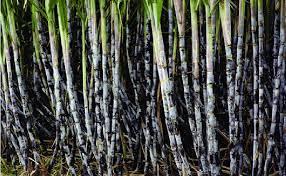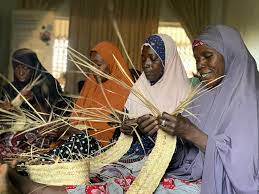
Sugarcane has a botanical name of Saccharum officinarum, is a perennial, tall grass, which looks like a bamboo cane and grows well in tropical areas (warm temperate). The plants are two to six (2–6) m tall with stout, jointed, fibrous stalks that are rich in sucrose, which accumulates in the stalk internodes. The stalk consists of fourteen percent (14%), sixty-eight percent (68%), fifteen percent (15%) and three percent (3%) more or less of fibre, water, soluble sugar and non-sugar respectively.
Sugarcane can be cultivated almost in all the states locally but commercially it is produced in; Kastina, Taraba, Kano, Adamawa, Jigawa, Kaduna, Kebbi, and Sokoto State.
Sugarcane farming has become an increasingly popular agricultural venture in Nigeria, thanks to the country's favorable climate and growing demand for sugar and its by-products. Sugarcane cultivation not only provides an excellent opportunity for farmers to generate substantial income but also contributes to the country's economic growth and development.
This article aims to provide a comprehensive guide on how to start sugarcane farming in Nigeria, covering essential aspects such as land preparation, variety selection, planting techniques, irrigation, fertilization, pest and disease management, harvesting, and marketing.
Land Preparation
Before embarking on sugarcane farming, it is crucial to select suitable land for cultivation. Sugarcane thrives in well-drained, loamy or sandy soils with a pH level between 5.5 and 7.5. The land should be cleared of weeds, rocks, and debris and plowed to a depth of at least 20 centimeters to ensure proper root development. It is also advisable to incorporate organic matter into the soil to enhance its fertility and water-holding capacity.
Variety Selection
Choosing the right sugarcane variety is crucial for maximizing yield and profitability. In Nigeria, popular sugarcane varieties include NCo 310, N47-48, N37-15, N57-125, and NCO 376.
R579 Variety: The R579 variety is one of the most popular sugarcane varieties cultivated in Nigeria. It is known for its high sugar content and excellent yield potential. This variety is well-suited for both rain-fed and irrigated farming systems. The R579 variety is disease-resistant, making it a preferred choice for farmers across the country. It has a medium to tall height, and the maturity period ranges from 12 to 14 months.
N57-3 Variety: The N57-3 variety is another commonly grown sugarcane variety in Nigeria. It is recognized for its high sucrose content and good tolerance to drought conditions. The N57-3 variety is well-adapted to both irrigated and rain-fed farming systems, making it a versatile choice for farmers. It has a medium height and matures in approximately 12 months.
CO-419 Variety: The CO-419 variety is a hybrid sugarcane variety that is gaining popularity in Nigeria. It is known for its high yield potential and good adaptability to various climatic conditions. This variety has a shorter maturity period of around 10 to 11 months, making it an attractive option for farmers looking for a quicker turnaround. The CO-419 variety has medium height and good resistance to pests and diseases.
N13 Variety: The N13 variety is a local sugarcane variety that has been cultivated in Nigeria for many years. It is valued for its good resistance to drought and its ability to grow in marginal soil conditions. The N13 variety has a medium height and matures in approximately 12 months. Although it may have a lower sugar content compared to some other varieties, it compensates with its adaptability and resilience.
CO-1148 Variety: The CO-1148 variety is a high-yielding hybrid sugarcane variety that has shown promising results in Nigeria. It has good resistance to lodging and diseases, making it a reliable choice for farmers. This variety has a tall height and a maturity period of around 12 to 14 months. The CO-1148 variety requires careful management due to its susceptibility to waterlogging.
Consider factors such as disease resistance, growth characteristics, yield potential, and suitability to your specific climate and soil conditions when selecting the varieties. Consult local agricultural extension services or reputable nurseries for guidance on the best varieties for your region.
Planting Techniques
Sugarcane can be propagated through stem cuttings, also known as setts. Prepare the setts by selecting healthy, disease-free cane stalks and cutting them into 20-25 centimeter-long pieces, ensuring that each sett has at least two nodes.
Plant the setts vertically or at a slight angle, with one end positioned slightly above the soil surface to prevent rotting. Maintain a spacing of 90-120 centimeters between rows and 15-20 centimeters between setts within rows to allow for proper growth and maintenance.
Irrigation
Sugarcane requires adequate moisture for optimum growth and yield. In regions with low rainfall, it is essential to establish an effective irrigation system. Drip irrigation and sprinkler irrigation are commonly used methods in sugarcane farming. Ensure that the plants receive sufficient water during the critical growth stages, such as germination, tillering, and maturation. Monitor soil moisture regularly and adjust irrigation schedules accordingly.
Fertilization
Proper fertilization is essential to meet the nutritional requirements of sugarcane plants. Conduct a soil test to determine the nutrient levels and pH of the soil. Based on the test results, apply organic manure and inorganic fertilizers to replenish nutrient deficiencies. Nitrogen, phosphorus, and potassium are the primary macronutrients required for sugarcane cultivation. Apply fertilizers in split doses during different growth stages to promote healthy plant development and maximize yield potential.
Pest and Disease Management
Sugarcane is susceptible to various pests and diseases that can significantly impact crop productivity. Common pests include sugarcane aphids, white grubs, armyworms, and termites. Diseases such as smut, red rot, mosaic, and leaf scald can also affect sugarcane crops.
Pests Affecting Sugarcane Farming
Sugarcane Aphid (Melanaphis sacchari): The sugarcane aphid is one of the most damaging pests affecting sugarcane in Nigeria. It feeds on the sap of the plant, causing stunted growth, yellowing of leaves, and reduced sugar content.
Implementing integrated pest management (IPM) practices, such as biological control using natural predators or the application of insecticides, can help control this pest effectively.
Sugarcane Borers (Eldana saccharina and Chilo spp.): Sugarcane borers are major pests that tunnel into sugarcane stalks, leading to yield losses and increased vulnerability to diseases. Regular monitoring, proper field sanitation, and the use of resistant varieties are key strategies for managing sugarcane borers. In severe infestations, chemical control can be considered.
White Grubs (Heteronychus spp.): White grubs are soil-dwelling pests that feed on sugarcane roots, leading to stunted growth and reduced cane yield. Crop rotation, use of resistant cultivars, and applying biocontrol agents like entomopathogenic nematodes can help manage white grubs effectively.
Diseases Affecting Sugarcane Farming
Sugarcane Smut (Sporisorium scitamineum): Sugarcane smut is a fungal disease that affects sugarcane leaves, stalks, and inflorescences. It causes black, elongated spore masses, leading to yield losses and reduced sugar content. Crop rotation, removal of infected plants, and fungicide application can help manage smut effectively.
Red Rot (Colletotrichum falcatum): Red rot is a devastating fungal disease affecting sugarcane in Nigeria. It causes red discoloration of internodes, rotting of stalks, and significant yield losses. Planting disease-free seedlings, crop rotation, and adopting cultural practices such as proper drainage can help control red rot.
Ratoon Stunting Disease (Leifsonia xyli subsp. xyli): Ratoon stunting disease (RSD) affects sugarcane ratoons, leading to stunted growth, yellowing of leaves, and reduced cane yield. Using disease-free seed cane, proper field sanitation, and adopting resistant varieties are crucial for managing RSD.
Integrated Pest and Disease Management: Implementing an integrated approach is essential for effective pest and disease management in sugarcane farming:
Cultural Practices
- Crop rotation to disrupt pest and disease life cycles.
- Proper field sanitation, including removal of crop residues and weeds.
- Selecting disease-resistant and pest-tolerant varieties.
Biological Control
- Encouraging natural predators like ladybugs and lacewings.
- Using biocontrol agents such as entomopathogenic nematodes and beneficial fungi.
Chemical Control
- Judicious use of insecticides, fungicides, and nematicides, following recommended guidelines and safety precautions.
Monitoring and Early Detection
- Regular field scouting to identify pests and diseases at early stages.
- Prompt action to prevent their spread.
Harvesting
Sugarcane crops are typically ready for harvest between twelve and eighteen (12 and 18) months after planting, depending on the variety and growing conditions. Harvesting can be done manually or with the aid of machinery such as sugarcane harvesters.
Cut the mature sugarcane stalks close to the ground and remove the tops and leaves. Transport the harvested sugarcane to a processing facility as soon as possible to preserve its quality and sugar content.
Marketing
Establishing a reliable market for your sugarcane crop is crucial to ensure profitability. Engage with local sugar processing companies, industrial users, and potential buyers to understand their requirements and negotiate favorable contracts.
Additionally, consider value-added opportunities such as producing sugarcane juice, syrup, or molasses to diversify your product range and increase profitability.
Conclusion
Sugarcane farming presents a lucrative opportunity for Nigerian farmers to capitalize on the growing demand for sugar and its by-products. By following the steps outlined in this guide, aspiring sugarcane farmers can set a solid foundation for a successful venture. Remember to adapt the techniques and recommendations to suit your specific region and seek guidance from local agricultural experts and extension services.
With proper land preparation, variety selection, cultivation techniques, irrigation, fertilization, pest and disease management, harvesting, and effective marketing, sugarcane farming can become a sustainable and profitable agricultural enterprise in Nigeria.






















